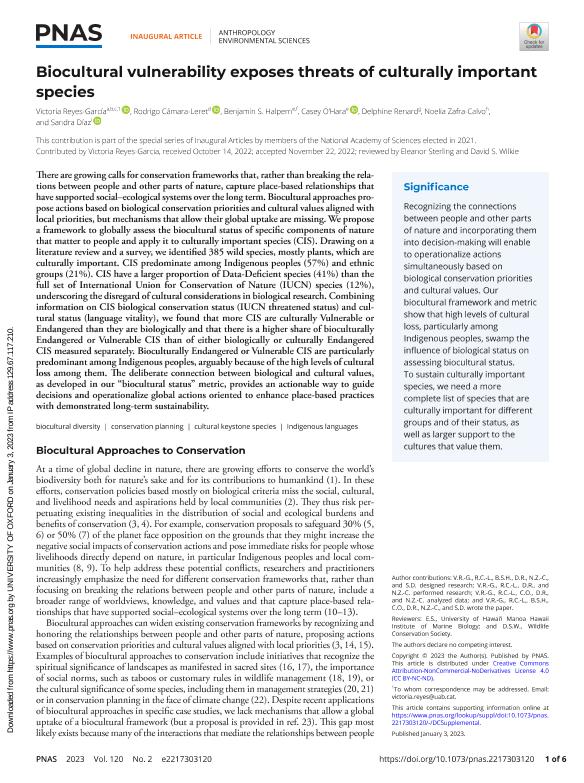Artículo
Biocultural vulnerability exposes threats of culturally important species
Reyes García, Victoria; Cámara Leret, Rodrigo; Halpern, Benjamin S.; O'Hara, Casey; Renard, Delphine; Zafra Calvo, Noelia; Díaz, Sandra Myrna

Fecha de publicación:
01/2023
Editorial:
National Academy of Sciences
Revista:
Proceedings of the National Academy of Sciences of The United States of America
ISSN:
0027-8424
e-ISSN:
1091-6490
Idioma:
Inglés
Tipo de recurso:
Artículo publicado
Clasificación temática:
Resumen
There are growing calls for conservation frameworks that, rather than breaking the relations between people and other parts of nature, capture place-based relationships that have supported social–ecological systems over the long term. Biocultural approaches propose actions based on biological conservation priorities and cultural values aligned with local priorities, but mechanisms that allow their global uptake are missing. We propose a framework to globally assess the biocultural status of specific components of nature that matter to people and apply it to culturally important species (CIS). Drawing on a literature review and a survey, we identified 385 wild species, mostly plants, which are culturally important. CIS predominate among Indigenous peoples (57%) and ethnic groups (21%). CIS have a larger proportion of Data-Deficient species (41%) than the full set of International Union for Conservation of Nature (IUCN) species (12%), underscoring the disregard of cultural considerations in biological research. Combining information on CIS biological conservation status (IUCN threatened status) and cultural status (language vitality), we found that more CIS are culturally Vulnerable or Endangered than they are biologically and that there is a higher share of bioculturally Endangered or Vulnerable CIS than of either biologically or culturally Endangered CIS measured separately. Bioculturally Endangered or Vulnerable CIS are particularly predominant among Indigenous peoples, arguably because of the high levels of cultural loss among them. The deliberate connection between biological and cultural values, as developed in our “biocultural status” metric, provides an actionable way to guide decisions and operationalize global actions oriented to enhance place-based practices with demonstrated long-term sustainability.
Archivos asociados
Licencia
Identificadores
Colecciones
Articulos(IMBIV)
Articulos de INST.MULTIDISCIPL.DE BIOLOGIA VEGETAL (P)
Articulos de INST.MULTIDISCIPL.DE BIOLOGIA VEGETAL (P)
Citación
Reyes García, Victoria; Cámara Leret, Rodrigo; Halpern, Benjamin S.; O'Hara, Casey; Renard, Delphine; et al.; Biocultural vulnerability exposes threats of culturally important species; National Academy of Sciences; Proceedings of the National Academy of Sciences of The United States of America; 120; 2; 1-2023; 1-6
Compartir
Altmétricas



